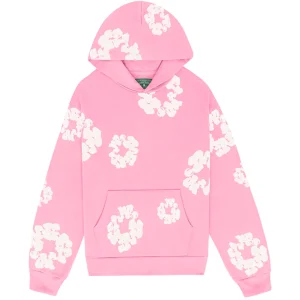Owning a piece from Denim Tears isn’t just about adding another pair of jeans or a hoodie to your wardrobe — it’s about wearing a story. Founded by Tremaine Emory, the brand is built on cultural consciousness and craftsmanship. Each item tells a story of Black history, heritage, and resilience, often symbolized through its signature denim tears cotton wreath motifs and intricate embroidery.Because every Denim Tears piece carries both artistic and historical significance, caring for it properly isn’t simply about preserving fabric — it’s about respecting meaning. Here’s how to maintain the look, feel, and symbolism of your Denim Tears apparel so that it remains timeless, intentional, and true to its roots.
1. Understand the Philosophy Behind the Fabric
Before you even think about washing or storing your Denim Tears apparel, it’s worth understanding the deeper philosophy behind it. Tremaine Emory intentionally chooses materials like cotton and denim — fabrics historically tied to the Black experience in America. Cotton, once a symbol of exploitation, is reimagined as a canvas of empowerment.
Caring for your Denim Tears clothing means acknowledging that these materials hold more than aesthetic value. When you wash or wear your pieces, you are participating in a conversation about reclamation and remembrance. Treat them with the same reverence you’d give a work of art — because, in truth, they are.
2. Washing: Gentle Is the Golden Rule
Denim Tears apparel is often constructed with high-quality denim, screen printing, embroidery, and pigment-dyed cotton. These materials are durable but require gentle care to preserve their character.
For Denim Pieces (Jeans, Jackets):
- Wash infrequently. Overwashing can fade the cotton wreath prints and natural dye patterns. Ideally, wash denim after every 5–10 wears.
- Cold water only. Always use cold water to preserve color and prevent shrinkage.
- Turn inside out. This reduces friction on printed or embroidered details.
- Use mild detergent. Avoid bleach or harsh chemicals that can strip dyes or damage patches.
- Air dry flat. Never tumble dry. Hang drying may cause stretch; laying flat ensures shape retention.
If your denim develops a lived-in fade, embrace it. Denim Tears pieces are designed to evolve with time — the fading, creasing, and wear patterns become part of your personal story.
For Cotton Hoodies and T-Shirts:
- Wash on a gentle cycle with similar colors.
- Use a delicate detergent — preferably plant-based.
- Avoid high heat drying, as it can crack screen prints or distort embroidery.
- Air dry or tumble dry low if necessary.
- To prevent fading of the iconic cotton wreath logo, turn garments inside out before washing.
3. Spot Cleaning for Longevity
For small stains or marks, spot cleaning is often better than a full wash. Use a damp cloth and a small amount of gentle soap or white vinegar to dab at the stain — never rub harshly, as it may lift pigment or embroidery threads.
For tougher stains, use a soft-bristle brush and light circular motions. The goal is to remove dirt while maintaining the garment’s natural patina. Remember: every scuff or mark tells part of the story. Perfection isn’t the goal — preservation is.
4. Storage: Keep It Cool, Dry, and Thoughtful
Proper storage is key to extending the life of your Denim Tears pieces.
- Avoid direct sunlight: Prolonged exposure can cause fading, especially on darker denim and printed cotton.
- Use padded or wooden hangers: Wire hangers can distort shoulder shapes or snag embroidery threads.
- Fold graphic tees and hoodies: Folding protects the artwork from stretching.
- Keep them ventilated: Store in breathable cotton garment bags, not plastic — airflow prevents mildew and maintains fabric health.
Think of your closet as an archive, not just a storage space. These clothes are living artifacts, and how you store them determines how they’ll age over time.
5. Ironing and Steaming: Handle with Care
If your Denim Tears apparel wrinkles, be careful not to damage printed or embroidered areas.
- Iron inside-out on a low to medium setting.
- Avoid direct heat on designs — use a pressing cloth or thin towel to protect prints.
- Steam gently for hoodies and cotton pieces; this helps retain shape and prevents cracking on logos.
For denim, light steaming can help relax fibers without flattening the natural texture that develops over time.
6. Caring for Collaborations and Limited Pieces
Many Denim Tears items are released as part of special collaborations — with brands like Levi’s, Converse, or Champion — and these limited-edition pieces often feature unique fabrics and finishes.
For example, Denim Tears x Levi’s jeans may include natural indigo dyes or hand-stitched motifs, which react differently to washing. Always check the care label — some may recommend professional dry cleaning or hand washing only.
If you own rare or early drops, consider consulting a professional garment conservator for long-term preservation. Think of it as you would caring for a limited-edition print or sculpture — these items are collector’s pieces, and proper maintenance enhances both their aesthetic and historical value.
7. Repair: Embrace the Art of Mending
Denim Tears is built on the idea of endurance — and that includes how you handle wear and tear. When small rips or frays appear, don’t see them as flaws. Instead, see them as opportunities for repair as storytelling.
Use traditional mending techniques like sashiko stitching or patchwork, which not only extend the life of your piece but also add layers of personality and history. A repaired Denim Tears garment becomes even more meaningful — a blend of the designer’s vision and your lived experience.
8. Sustainability and Mindful Ownership
At its core, Denim Tears is about mindfulness — understanding the origin, purpose, and future of what you wear. Caring for your pieces is also an act of sustainability. By washing less, repairing more, and appreciating the artistry in every detail, you’re rejecting the wastefulness of fast fashion.
Tremaine Emory often speaks about fashion as a cultural archive. Each item from Denim Tears holds historical and emotional weight — and caring for them ensures those stories continue to be told, generation after generation.
9. Passing It On: Denim as Heirloom
Because Denim Tears clothing is designed Denim Tears Jeans to age gracefully, it can be passed down. The fade of your jeans, the softening of your hoodie, and the worn edges of embroidery all carry memories. Passing your pieces on — to family, friends, or collectors — turns fashion into legacy.
In this way, Denim Tears transcends trend. It becomes a vessel for continuity — a reminder that our clothes, like our culture, are meant to endure.
Conclusion: Care as Respect
Caring for your Denim Tears apparel isn’t just maintenance — it’s respect. It’s respect for the artistry, for the history, and for the message Tremaine Emory built his brand upon. Each time you wash, mend, or fold one of these garments, you’re not only preserving its form — you’re honoring its story.
Denim Tears asks its wearers to think deeply about what they wear and why. Proper care is part of that consciousness. It’s a quiet act of love — for the fabric, for the culture, and for the message that fashion, when made with purpose, can carry through time.



